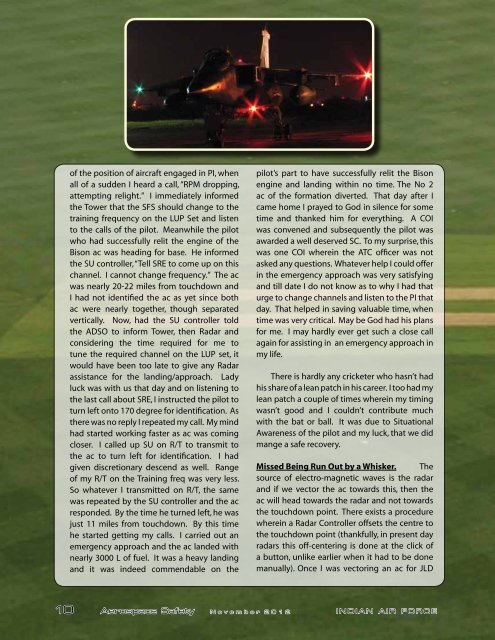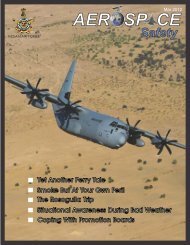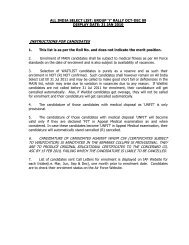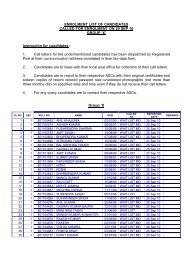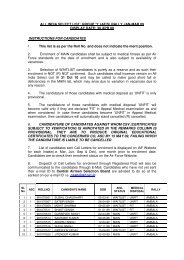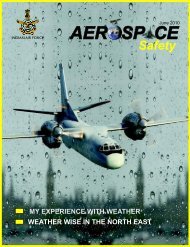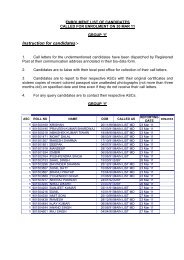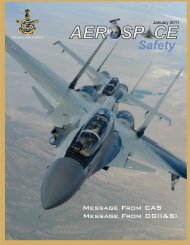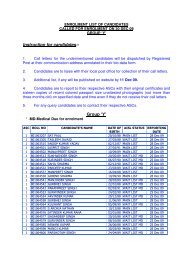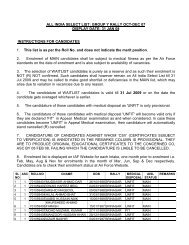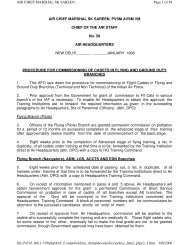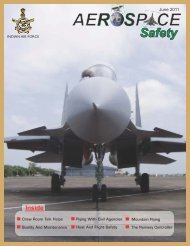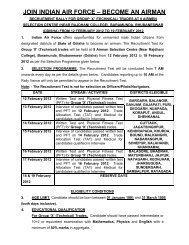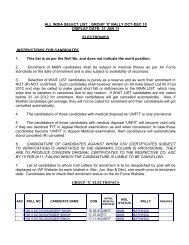November 2012 - Indian Airforce
November 2012 - Indian Airforce
November 2012 - Indian Airforce
Create successful ePaper yourself
Turn your PDF publications into a flip-book with our unique Google optimized e-Paper software.
of the position of aircraft engaged in PI, when<br />
all of a sudden I heard a call, “RPM dropping,<br />
attempting relight.” I immediately informed<br />
the Tower that the SFS should change to the<br />
training frequency on the LUP Set and listen<br />
to the calls of the pilot. Meanwhile the pilot<br />
who had successfully relit the engine of the<br />
Bison ac was heading for base. He informed<br />
the SU controller, “Tell SRE to come up on this<br />
channel. I cannot change frequency.” The ac<br />
was nearly 20-22 miles from touchdown and<br />
I had not identified the ac as yet since both<br />
ac were nearly together, though separated<br />
vertically. Now, had the SU controller told<br />
the ADSO to inform Tower, then Radar and<br />
considering the time required for me to<br />
tune the required channel on the LUP set, it<br />
would have been too late to give any Radar<br />
assistance for the landing/approach. Lady<br />
luck was with us that day and on listening to<br />
the last call about SRE, I instructed the pilot to<br />
turn left onto 170 degree for identification. As<br />
there was no reply I repeated my call. My mind<br />
had started working faster as ac was coming<br />
closer. I called up SU on R/T to transmit to<br />
the ac to turn left for identification. I had<br />
given discretionary descend as well. Range<br />
of my R/T on the Training freq was very less.<br />
So whatever I transmitted on R/T, the same<br />
was repeated by the SU controller and the ac<br />
responded. By the time he turned left, he was<br />
just 11 miles from touchdown. By this time<br />
he started getting my calls. I carried out an<br />
emergency approach and the ac landed with<br />
nearly 3000 L of fuel. It was a heavy landing<br />
and it was indeed commendable on the<br />
pilot’s part to have successfully relit the Bison<br />
engine and landing within no time. The No 2<br />
ac of the formation diverted. That day after I<br />
came home I prayed to God in silence for some<br />
time and thanked him for everything. A COI<br />
was convened and subsequently the pilot was<br />
awarded a well deserved SC. To my surprise, this<br />
was one COI wherein the ATC officer was not<br />
asked any questions. Whatever help I could offer<br />
in the emergency approach was very satisfying<br />
and till date I do not know as to why I had that<br />
urge to change channels and listen to the PI that<br />
day. That helped in saving valuable time, when<br />
time was very critical. May be God had his plans<br />
for me. I may hardly ever get such a close call<br />
again for assisting in an emergency approach in<br />
my life.<br />
There is hardly any cricketer who hasn’t had<br />
his share of a lean patch in his career. I too had my<br />
lean patch a couple of times wherein my timing<br />
wasn’t good and I couldn’t contribute much<br />
with the bat or ball. It was due to Situational<br />
Awareness of the pilot and my luck, that we did<br />
mange a safe recovery.<br />
Missed Being Run Out by a Whisker. The<br />
source of electro-magnetic waves is the radar<br />
and if we vector the ac towards this, then the<br />
ac will head towards the radar and not towards<br />
the touchdown point. There exists a procedure<br />
wherein a Radar Controller offsets the centre to<br />
the touchdown point (thankfully, in present day<br />
radars this off-centering is done at the click of<br />
a button, unlike earlier when it had to be done<br />
manually). Once I was vectoring an ac for JLD<br />
10<br />
Aerospace Safety N o v e m b e r 2 0 1 2<br />
INDIAN AIR FORCE


